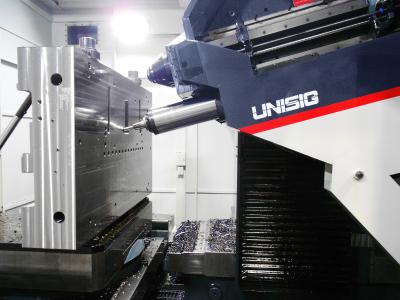
UNISIG continues to expand its product line to meet the growing needs of today’s manufacturers, especially moldmakers. The company offers the USC and USC-M series machines, which combine deep-hole drilling and milling capabilities to allow mold shops to reduce setup time, increase accuracy and eliminate mold design restrictions associated with traditional machining centers.
USC Series column-type machines feature superior machine alignment, rigid construction and choice components that provide a reliable and compact solution for mold manufacturers to perform BTA and gundrilling operations and generate highly accurate holes up to 1.5" in diameter in large workpieces. Available in table weight capacities up to 50 tons, machines in this series are ideal for workpieces such as mold plates and frack pumps. For increased part processing capability, milling spindles and rotary tables are also available as options with USC series machines.
The USC-M series of 7-axis deep-hole drilling and machining centers improve productivity and efficiency in mold production. These machines allow manufacturers to process large and small parts with four-sided machining capability in a single setup.
The USC-M series machines utilize two independent spindles: one for gundrilling and BTA drilling and a second CAT 50 machining spindle. When this additional capability is combined with a rotary workpiece table and programmable headstock inclination, accurate deep-hole drilling and all standard high-performance machining capabilities are available within the working envelope of the system.
The seven axes of control on the M-Series machines utilize the B, A, X, Y and Z axes for 5-axis machining operations, the W-axis for the combined gundrilling and BTA deep-hole drilling spindle, and the U-axis for machining. This provides 3-plus-2 machining to make deep-hole drilling and machining of compound angles faster and easier and improves productivity, as well as throughput by reducing setups and eliminating transfers to multiple machines. Using a deep-hole drilling headstock capable of conventional gundrilling and BTA high-performance drilling has proven to be five to seven times faster than gundrilling alone.
UNISIG engineers and manufactures both the USC and USC-M series in the United States with high-performance components. The company also offers a full complement of options for these machines to further enhance their milling and machining functions, including full-enclosure guarding, a 120-position automatic tool changer, a laser tool pre-setter and probing.
Upon machine installation, UNISIG provides its customers with comprehensive training that involves machine operation and process optimization as well as gundrill tool sharpening. The company also offers customers reference information and practical advice for proper machine operation.
Contact Details
Related Glossary Terms
- centers
centers
Cone-shaped pins that support a workpiece by one or two ends during machining. The centers fit into holes drilled in the workpiece ends. Centers that turn with the workpiece are called “live” centers; those that do not are called “dead” centers.
- gang cutting ( milling)
gang cutting ( milling)
Machining with several cutters mounted on a single arbor, generally for simultaneous cutting.
- gundrill
gundrill
Self-guided drill for producing deep holes with good accuracy and fine surface finish. Has coolant passages that deliver coolant to the tool/workpiece interface at high pressure.
- gundrilling
gundrilling
Drilling process using a self-guiding tool to produce deep, precise holes. High-pressure coolant is fed to the cutting area, usually through the gundrill’s shank.
- milling
milling
Machining operation in which metal or other material is removed by applying power to a rotating cutter. In vertical milling, the cutting tool is mounted vertically on the spindle. In horizontal milling, the cutting tool is mounted horizontally, either directly on the spindle or on an arbor. Horizontal milling is further broken down into conventional milling, where the cutter rotates opposite the direction of feed, or “up” into the workpiece; and climb milling, where the cutter rotates in the direction of feed, or “down” into the workpiece. Milling operations include plane or surface milling, endmilling, facemilling, angle milling, form milling and profiling.

